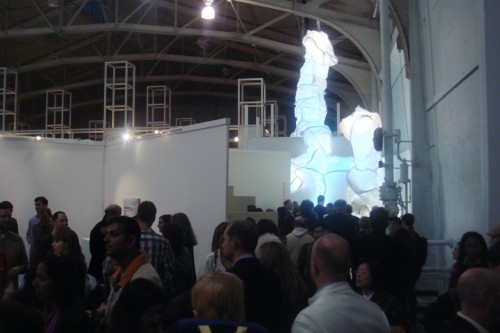On Graduate Exhibitions

The end of the spring term at art schools is marked by multiple convocations – symposia, commencements, barbecues, brunches, kaffeeklatsches – none more charged and peculiar than the graduate exhibition. A vast amount of effort, skilled thought, time and energy is expended on these events, by students, faculty and event organizers. And yet the exhibitions are as a rule ambiguous: grand, chaotic marketplaces where uneven intentions, practices and audiences converge upon one another.
My photographs, I should say, are from a specific event, San Francisco Art Institute’s 2009 Vernissage, but my remarks below aim to put forward some ideas about the general form, and not the one occasion.
What is a graduate exhibition anyways? Who is it for, and what status achieved by the artworks it includes? Its origin would seem to run very deep into the history of art education, to the moment when art study became the province of academies, rather than craft or guild apprenticeships. As a modernist I am out of my depth historically on this subject – most of what I know comes from one fantastic book – but it seems grad exhibitions reach back at least to the origins of the Salon, which began when the professors of the Académie royale de peinture et de sculpture in Paris hauled out the paintings of recent graduates of the Êcole for a semi-public comparison at the Salon Carré in 1673. Such salons would become a vital staging-ground for public judgment in the 18th century – the very idea of a public sphere emerges from such situations – as well as an important counter-force to the museums and noble collections.

Compare the contemporary grad show to an image of those Salons (this one A. Hadamart’s engraving of the Salon of 1699), though, and a number of differences immediately appear. Rather than a dense and cacophonous visual field, the contemporary grad exhibitions often hive their students into corners, zones or stalls, not unlike those of art fairs. This organization removes comparison from the visual field, and therefore obviates meaningful relationships among works by different artists. Artists too have increasingly insisted on determining the conditions of their exhibition, arranging works into constellations that aim to defy or compensate for their status as mere objects. An effect of this is that each artist is individuated, such that exhibition is foiled a frame for judgment; “Each artwork is defined by its intention to… stand alone.”
So too is critique assumed largely to happen anterior to exhibition, amongst the adepts in the studios. Public debate, such as it occurs, is baffled by the spaces of exhibition, funneled down hallways and scattered amongst cubicles. Charles Baudelaire cut his teeth in his twenties writing about the Salons critically. In contrast these modern Salon-like events are largely ceremonial culminations, secular bar mitzvahs. To criticize the grad shows, to write about them at all, would be to misrecognize this fact – which is not to say that such a misrecognition might not be worthwhile.

On the other hand, a curious visitor will discover that curators and gallerists do sometimes use grad shows to prowl for new artists. The demands of pedagogy dovetail too harmoniously at times with the logic of the market. Which is not to say that many succeed in getting shows or gallery representation from the event – but to say that this is the deceptive promise of the grad exhibition’s fair-like form.
Art schools are meant to be incubators of novel forms and styles of art-practice: “The future of culture,” as CCA’s slogan goes. Grad shows, however, often put forward alongside their “future” a broad range of styles and subjects deemed obsolete by magazines, museums and the market. Which institutions, need it be said, don’t necessarily or solely determine what art can do or mean. It would be too hopeful to suggest here, as Samuel Delany has argued of science fiction, that devalued margins may be places where more freedom can be found. But I don’t mind the idea of the school as partly a reservation for déclassé styles and forms of knowledge; they might be grounds from which difference can be pictured and the limits of the contemporary can be perceived.
Comments (7)
-
Julian Myers says:
May 27, 2009 at 4:04 pm
-
Tara McDowell says:
May 27, 2009 at 1:58 pm
-
Julian Myers says:
May 27, 2009 at 12:06 am
-
Suzanne says:
May 26, 2009 at 8:29 pm
-
Julian Myers says:
May 26, 2009 at 1:53 pm
-
Julian Myers says:
May 26, 2009 at 1:42 pm
-
Dominic says:
May 26, 2009 at 12:33 pm
See all responses (7)My point was that the exhibitions have neither a pedagogical function nor much of a public-discursive one, which is a letdown given the roots of the form. Sure, there are some distinctions to be made amongst the individual exhibitions (I had in mind also Cal Arts and SAIC). But I don’t think the overall logic is any different at CCA – do you?
To your second point: I wouldn’t think that a “broad range of styles and subjects deemed obsolete by magazines, museums and the market,” necessarily implies the work is “derivative,” just that it’s not what editors and curators are jazzed on at the moment. I guess I have a lot of things swimming around my thoughts here, in particular the writing on Asger Jorn in “Art Since 1900,” and Ian Burn’s misgivings about “deskilling” in “The ‘Sixties: Crisis and Aftermath.”
In particular this passage, speaking of art training after Conceptual Art:
“While persuasive arguments can be made in favor of discarding “anachronistic” practices in the face of “space-age” technologies, what is so often overlooked is that skills are not merely manual dexterity but forms of knowledge. The acquisition of particular skills implies an access to a body of accumulated knowledge. Thus deskilling means a rupture within an historical body of knowledge – in other words, a dehistoricization of the practice of art.”
While I agree in principle with most of the post, Julian, in some ways it’s not quite right to say that these shows all take the same form. SFAI, for example, is much more “hived,” with students getting their own “booth,” than CCA, where there are many medium-sized galleries that include pairs or trios of artists put together to elicit the very comparisons you remark on as being elided.
True, the shows function more as entertainment/shopping/strolling than spaces for public discourse. The salon had this e/s/s function, but also had 75 reviews. And finally, I wish you had said more about why an art school, when a bastion for derivative styles, can picture difference or expose the limits of the contemporary. If this is the best position from which to understand or critique “the contemporary” (and is it so homogenous?), we’re in sorry shape.
I don’t think Vis Crit students write about the MFAs in their classes. At that point there’s not really enough of a practice to write about, and things are often in flux. But I don’t know that it’s discouraged. It’s probably just not a great idea. (But I don’t teach in Vis Crit so maybe I’m missing something.) Curatorial Practice students at CCA _have_ included MFAs in their thesis exhibitions. Dina Danish, Patricia Esquivias, Andrew Tosiello and Hillary Wiedemann, off the top of my head.
But I don’t quite understand what that proves or doesn’t prove?
I want to clarify, Dominic, do you mean that student curators always put together their grad exhibitions with professional artists rather than fellow student artists? That’s the equivalent of student editors only publishing their teachers or established writers. (not sure abt the vanity press equivalent, unless the implication is about how expensive it is to go to graduate art school.) I asked Julian the other day, with respect to this post, if visual criticism students were encouraged along the way to test & sharpen their skills by writing about their fellow students’ work. I’m pretty sure–correct me Julian?—that this is in fact discouraged. Tonight I’m wondering—as I don’t know so well how these programs work—if there’s ever (or maybe there is usually?) a practicum or situational, say for the last month, or quarter, of all programs about-to-graduate in a given art school—CCA would be a good candidate for this—with a Stanford Prison Experiment-like set up. The writers review the student artists, and the student-curated shows, the curators curate only from their fellow student pool, and why not have some students assigned to stand in for relative values of wealth, class, purchasing power, education, taste, ownership of media sources, etc—or is all that already implicit or explicit?
That said, the problems that inhere to the MFA exhibitions are not exactly the same for the Curatorial programs. The exhibitions created by those programs are premised upon collaborative relationships among students, and aim (mostly) to structure visible and meaningful relationships amongst artists in their exhibitions.
I concur, though my position does complicate my objective evaluation. Because I have an inside view, I see the exhibitions as the results of an educational process. One can learn things, perhaps even more things, from a strange exhibition as a successful one. Whether they’re good or not is beside the point.
The larger problem is institutional and cultural: an educational culture that demands, on every other level and in every other context, individuation (above I trace this to the logic of the market).
I agree with all this. I guess they are a little like vanity publishing. But, Julian, what about the grad shows (always of professional artists) presented by students of curating? We’ve both (full disclosure) taught on the curating programs at both SFAI and CCA. Those are even stranger phenomena no?